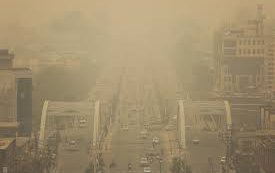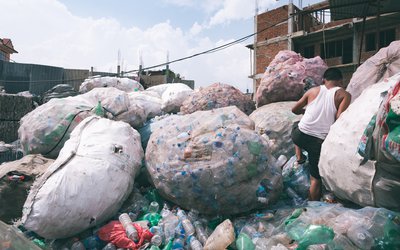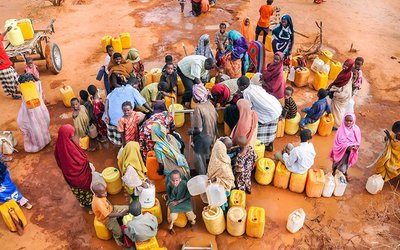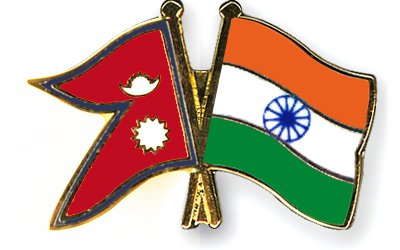
Himalayan glaciers have been retreating, shrinking and losing mass, since the 1960s consistent with rising temperatures and decreasing precipitation.
In contrast, glaciers in the northwest region of Karakoram have shown stable mass balances since the 1970s, likely due to cooler summer temperatures, increased snowfall, and a lower sensitivity to climate change.
Mass wastage is resulting in rising debris-cover on glaciers and more glacial lakes. Extreme rainfall events in the future may cause floods due to the bursting of glacial lakes, posing a threat to mountain communities.
At the top of the world, the iconic and majestic Himalayas boast a quarter of the almost 200,000 mountain glaciers found on Earth. Dubbed the “water towers of Asia”, these lofty glaciers store huge amounts of freshwater. In late spring, summer and early autumn, snow and glacial melt runoff feeds India’s most important rivers – the Indus, Ganges and Brahmaputra – and is used for drinking, irrigating farmland and powering hydro-electric plants for almost half of India’s population.
Glaciers are vulnerable to rising temperatures and changes in precipitation. With the livelihood and water security of almost a billion people living in the Himalayan countries – Pakistan, China, India, Nepal, and Bhutan – at stake, glaciologists are scrambling to monitor the health and dynamics of these precious glaciers.

The various regions of the Himalayas along with the three main river basins – the Indus, Ganges, and Brahmaputra. Map by Kulkarni et al. (2018).
Now, an international team of scientists has comprehensively reviewed the state of Himalayan and Karakoram glaciers confirming that Himalayan glaciers are indeed retreating, shrinking in area, and losing mass while in the northwest Karakoram Range – traversing the borders of Pakistan, India, and China – mass has been stable. As ice mass wastes away, researchers have witnessed an increase in glacial debris-cover and lakes and are projecting a surge in melt runoff until 2050.
The “new review is welcome” given the “manifold studies” published over the past few years, said Tobias Bolch, a glaciologist at the University of Zurich, who was the lead author of the last review in 2012 on the long-term state of Himalayan glaciers.
“Most important is that some biased in-situ (field-based) measurements were excluded for providing the best estimates of glaciers’ mass changes in the Himalayas. The best estimate is less negative than estimated before, but the mass loss is still significant,” he highlighted.
Challenges in conducting field work on glaciers
Glaciologists assess the health of glaciers by studying their mass balance, length and area, among other features. Glaciers gain mass (accumulation) mainly by snowfall and when avalanches occur while they lose mass (ablation) by melting and sublimation (evaporation of ice without melting). When more mass is lost than gained, the mass balance of a glacier is negative. Surface mass loss is a direct and swift response to a warming climate whereas decreasing glacial area and length, for example, are slower, taking a few decades to a century to show up.
Directly measuring the mass balance is often hampered by the inaccessibility of the region due to various obstacles like the treacherously jagged terrain, the high elevations, and the hostile weather conditions. Consequently, field measurements are scarce; most studies rely on the trove of indirect data obtained from satellites.
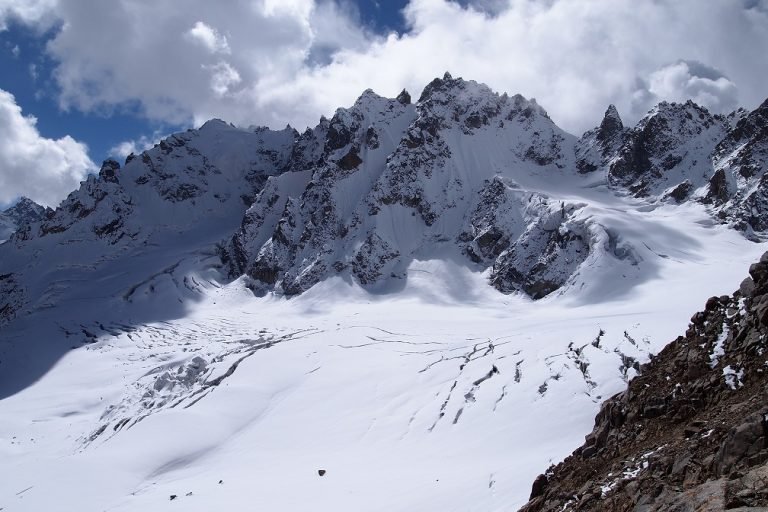
Chhota Shigri glacier located in the state of Himachal Pradesh in the western Himalayas (approx. 5200 metres above sea level). Photo by MF Azam.
Some past field studies were biased and one reason, says glaciologist Christian Vincent from the University of Grenoble in France and co-author of the study, was that they were based on the more-accessible smaller and lower elevation glaciers, which tend to have a lower mass balance.
Using data from those studies led to a higher average mass loss compared with satellite-based estimations and inaccurately reflected the responses of the glaciers in the region, said Etienne Berthier, a glaciologist at University of Toulouse in France and co-author of the study. He added that it also led to an overestimation of the contribution of glacier wastage to sea-level rise.
A further complication: Even within the same region, individual glacier responses are varied depending on factors such as their avalanche activity and extent of debris-cover. Field studies based on carefully selected glaciers with limited debris-cover and avalanche activity are needed to validate satellite-based estimates, said Mohd Farooq Azam, lead author of the review and a glacio-hydrologist at the Indian Institute of Technology in Indore.
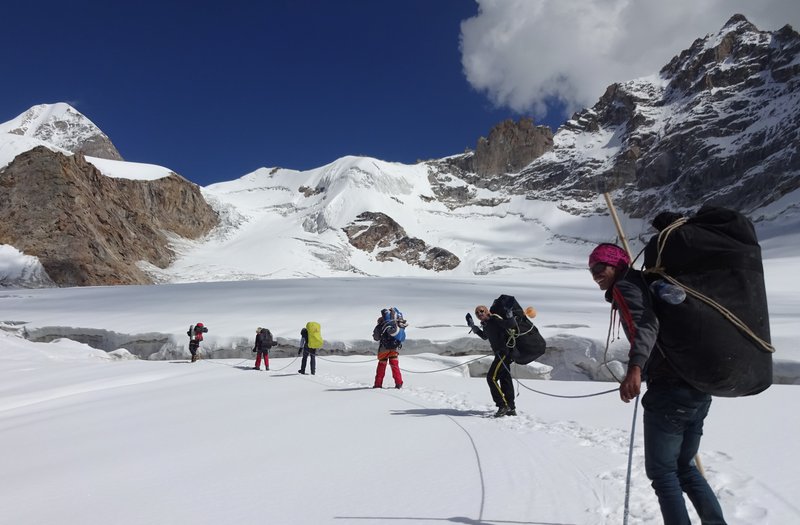
Azam leading his team on Chhota Shigri Glacier located in the state of Himachal Pradesh in the western Himalayas (approx. 5200 metres above sea level). Photo by Ali.
A consistent decline in the Himalayas versus stability in the Karakoram
After weeding out dubious field-data, the team found that the average glacier mass wastage in the Himalayas from 1975 to 2015 (–0.49 metres of water equivalent per year) is similar to estimates from satellite-derived data (–0.37 metres of water equivalent per year) and also agrees with the global average until 2000, after which mass loss appears to be less negative. The reasons for the decreasing mass loss are unknown and is “the next standing question,” said Azam.
Since the 1960s, most glaciers in the Himalayas are retreating, shrinking in area, and losing mass consistent with rising temperatures and decreasing precipitation. On an average, Himalayan glaciers shrunk 0.36 percent in area per year from 1960 to 2010, which is lower than the shrinkage rate of 0.57 percent per year during the same period for the entire High Mountain Asia (HMA) region covering the Hindu Kush in the west and Tien Shan up in the north.
But there is an exception: Glaciers in the heavily glaciated northwest Karakoram region and the western part of the Tibetan Plateau have had, on average, stable mass balances since the 1970s—with some even gaining mass—known as the Karakoram anomaly. The unusual stability, the researchers believe, is likely due to cooler summer temperatures, increased snowfall, and a lower sensitivity to changes in temperature.
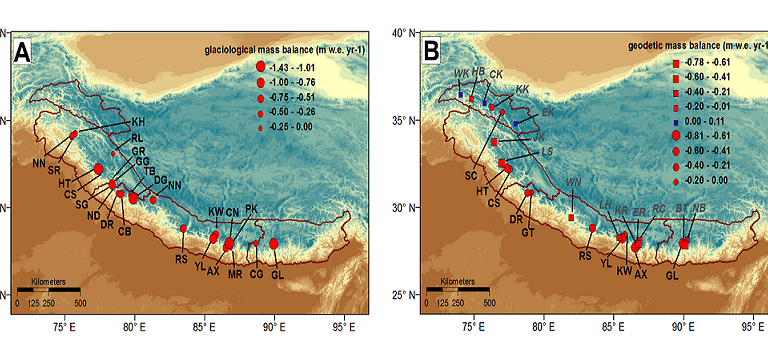
A. Map shows the field-based mass balances (m w.e. a−1 refers to metres of water equivalent per year) for 24 glaciers in the Himalayas and the Karakoram region up in the northwest (the observation time period varies for each glacier and can be accessed in the supplementary tables). All are losing mass albeit at different rates. B. Map shows satellite-based mass balances for 10 glaciers (circles) and 24 basins/regions (squares). Red colour represents negative mass balances, whereas blue color represents positive mass balances. While all Himalayan glaciers are losing mass, some in the northwest Karakoram are gaining mass. Maps modified from Figure 2 of Azam et al., 2018.
Understanding the behavior of these glaciers is complicated by a phenomenon called surging. “Glaciers in the Karakoram Range are behaving completely different than other glaciers in the world,” said Azam. “This is due to the surging (sudden advancement) of some of the glaciers,” but the exact mechanism “is not well understood at the moment.”
In the dry regions of Karakoram, the central Tibetan Plateau, and Ladakh, especially in areas where the monsoon doesn’t reach, “sublimation could be a significant loss contributor,” added Azam.
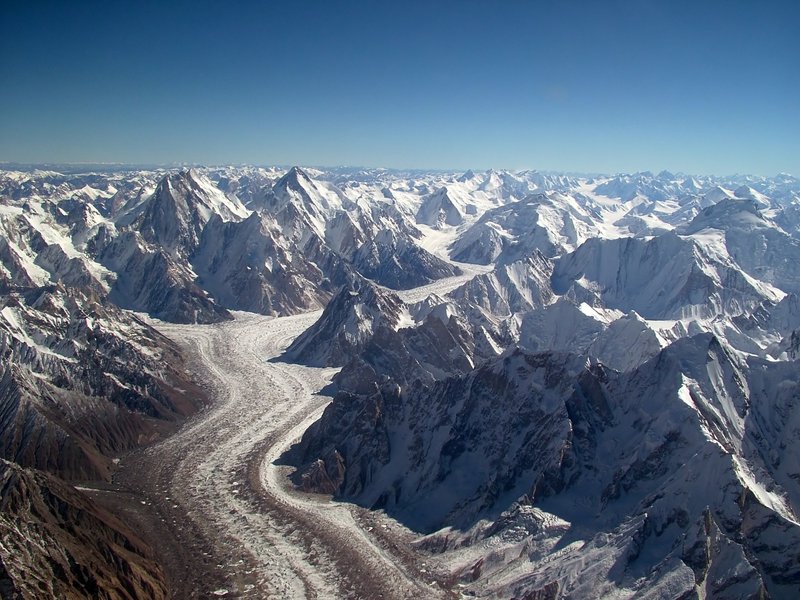
Baltoro Glacier in the heavily glaciated northwest region of Karakoram. Photo by Guilhem Vellut/Wikimedia Commons.
The sun’s shortwave energy that is absorbed by glaciers contributes the most to glacier melting in the Himalayas, said Azam. So, glacier wastage is very sensitive to changes in surface albedo (a measure of the reflected shortwave radiation out of the total incoming shortwave radiation), explained Koji Fujita, a glaciologist at Japan’s Nagoya University, and co-author of the study. Snowfall increases surface albedo meaning more energy is reflected and so less is absorbed by the glacier, which reduces melting.
With glacial area shrinking, larger glaciers have become fragmented giving rise to many smaller glaciers over the past five to six decades. Small glaciers as well as those at lower elevations, the team notes, are “shrinking faster than larger ones.”
The western Himalayan glaciers are losing mass slightly more rapidly than the central and eastern Himalayas, observed Azam.Bolch agreed, stating that this has been the trend for the last two decades adding that his own recent satellite-based study from the Lahaul-Spiti region in the Indian western Himalayas found that mass loss has intensified since 2000. He suggested that this may be because glaciers in this region “are located on average on lower elevation” exposing them to higher temperatures. As you move northward closer to the Karakoram, mass loss is lower, he pointed out.
Rising debris cover and glacial lakes
Debris-covered glaciers are common throughout the Himalayas, said Anil Kulkarni, a scientist at the Divecha Center for Climate Change at the Indian Institute of Science, Bangalore. This debris, explained Azam, originates from past avalanches and weathering of rocks from the steep walls of the valley. “Then they are buried with snow for several years and travel with the glacier.”
As glacial mass has shrunk, said Azam, embedded debris at the lower parts of the glaciers, especially at the snout, where most melting occurs, is exposed. As a result, surface-debris, also known as supraglacial debris-cover, has been increasing over the past 5-6 decades. “The upper boundaries of clean and debris-covered ice are getting pushed back higher,” said Argha Banerjee, a glaciologist at the Indian Institute of Science Education and Research in Pune.
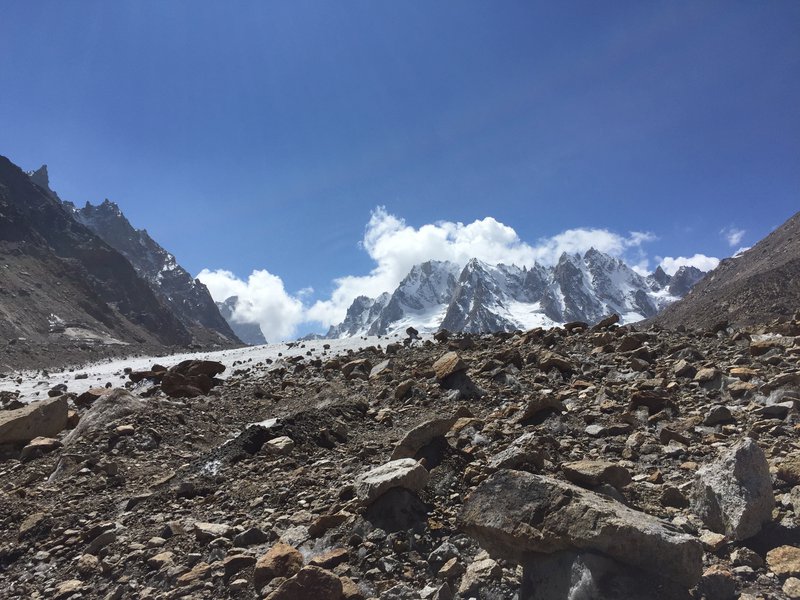
Debris cover over Chhota Shigri Glacier tongue at approx. 4300 metres above sea level. Photo by MF Azam.
Recently, Kulkarni along with his colleague found a steady rise in supraglacial debris-cover on 48 glaciers in the Baspa basin located in the western Indian Himalayas from 1997 to 2014. As the “thickness of ice reduces”, said Kulkarni, more debris along the sides of the glacier are exposed.
Azam says that the blanket of supraglacial debris, if thick enough, can protect glaciers from the rising temperatures due to their insulating effect. A moderate layer of debris may initially provide some protection, said Kulkarni. But Banerjee reveals that “while initial ice-loss rates are lower in debris-covered glaciers, over a few decades, they catch up with their debris-free counterparts and may lose mass at higher rates.”
Bolch explained that this is because “debris-covered glaciers are prone for the development of exposed ice cliffs” and lakes on the surface of glaciers known as supraglacial lakes, “which are hot spots of ice melt.” He added that “the tongues of debris-covered glaciers are on average located at lower elevation where they are now exposed to higher temperatures.”
Another consequence of melting ice: glacial lakes are cropping up. Patrick Wagnon, a glaciologist at the University of Grenoble and co-author of the review, observed that glacial lakes are growing both in number and in size over the past few decades, especially in the central and eastern regions of the Himalayas such as in Nepal, Bhutan, and the Indian state of Sikkim.
These lakes, he noted, can accelerate melting. “Supraglacial lakes absorb more of the sun’s energy than the surrounding debris-covered areas, resulting in more heat transferred to the glacier,” he elaborated. And glaciers with lakes forming at the end show an “increased velocity at their snout and have an accelerated mass loss due to calving.”
Changes in meltwater runoff and risk of floods
Based on future climate projections, meltwater runoff in the Himalayas is expected to rise until 2050, after which it should drop as glaciers shrink further. But the authors caution that there are large uncertainties in future runoff because of the wide range of glacial area and volume estimates.
The “tipping point”—when meltwater starts to decline—for individual basins depends on the size of the glaciers, among other factors, stressed Bolch. For the Indus basin, the tipping point is projected to be later on in the century, he said, whereas for the eastern basins it is expected to be earlier. “One of the reasons is that the Indus basin” which includes the stable Karakoram glaciers, “contains on average larger and thicker glaciers,” he elaborated.
According to a recent projection, maximum runoff in the Indus basin may occur around 2070, while for most headwaters of the Ganges it is anticipated around 2050, and for the headwaters of the Brahmaputra, it is imminent or may even have already passed.
“Glacier runoff is much more important in the western Indus basin where winter precipitation prevails and the summers are dry while in the eastern basin the melt season coincides with the summer monsoon precipitation,” added Bolch.
With flourishing glacial lakes and greater projected meltwater runoff, extreme rainfall events in the future could trigger landslides and floods as glacial lakes burst, endangering communities living in the mountains. “There are several lakes in the Himalaya which are potentially dangerous and may burst any time,” noted Azam. “These lakes are mostly located in Nepal and Bhutan, but other Himalayan countries also have such glacier lakes.”

Lake Sabai Tso in Hinku Valley Nepal at approx. 4600m, which was responsible for a glacial lake outburst flood on 1 September, 1998. Photo by P. Wagnon.
In June 2013, heavy rainfall “due to the confluence of the western disturbance and the Indian summer monsoon” in the Indian state of Uttarakhand in the central Himalayas, said Azam, triggered the collapse of the Chorabari glacier lake. This unleashed a torrent of water, along with debris that dammed the lake, which hurtled downstream over the town of Kedarnath, causing deadly floods that killed hundreds of people. It was an “unfortunate historic disaster”, he rued.
Future of Himalayan glacier research
According to Jeffrey Kargel, a senior scientist at the Planetary Science Institute (USA) and co-author of this review “the pace of glacier wastage is fast enough that many applications and interests should consider climate-change induced glacier responses and associated hydrological changes, but is slow enough that well-planned and locally tailored approaches to adaptation are both possible and needed.”
To shed further light on the state of Himalayan glaciers, Azam and his team urges government authorities to allocate more funds to expand field-based studies on glaciers and to train budding glaciologists. He proposes establishing a “network of high altitude meteorological and discharge stations covering more glaciers and watersheds in the Himalayan-Karakoram region.”
Further, he suggests developing “data sharing policies among the Himalayan-Karakoram countries so that large-scale modelling of future glacier and runoff evolution can be done with improved accuracy.”
This article is first published in MONGABAYINDIA.COM. All photos and graphics are also taken from Mongabayindia.com. Excerpts of the article.
